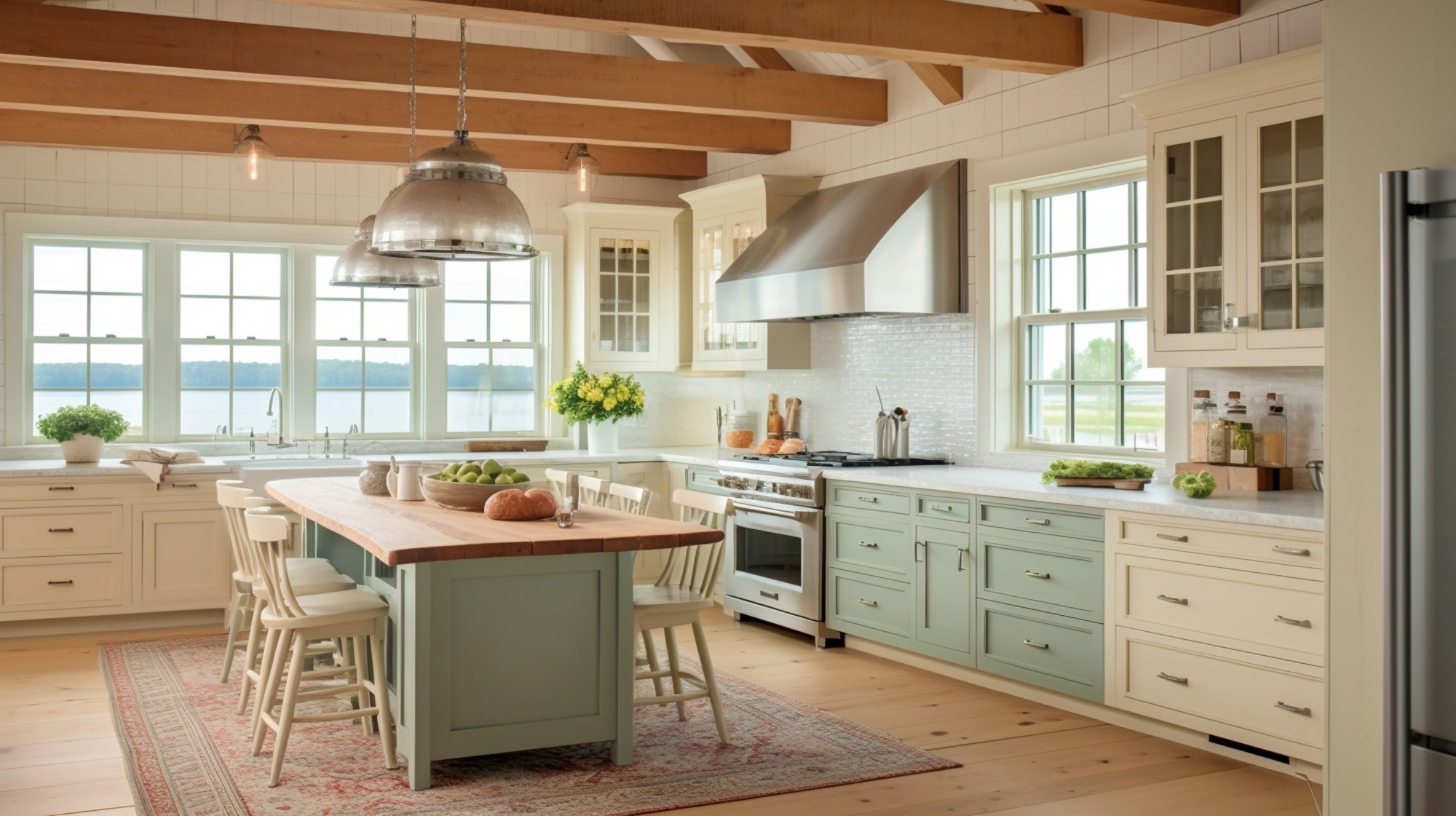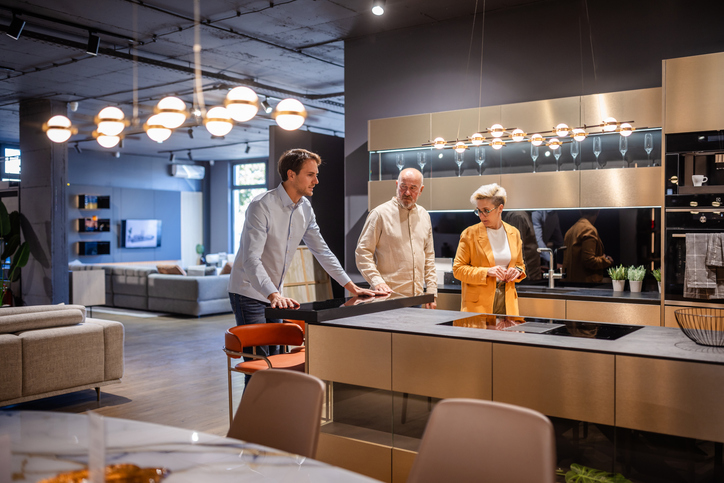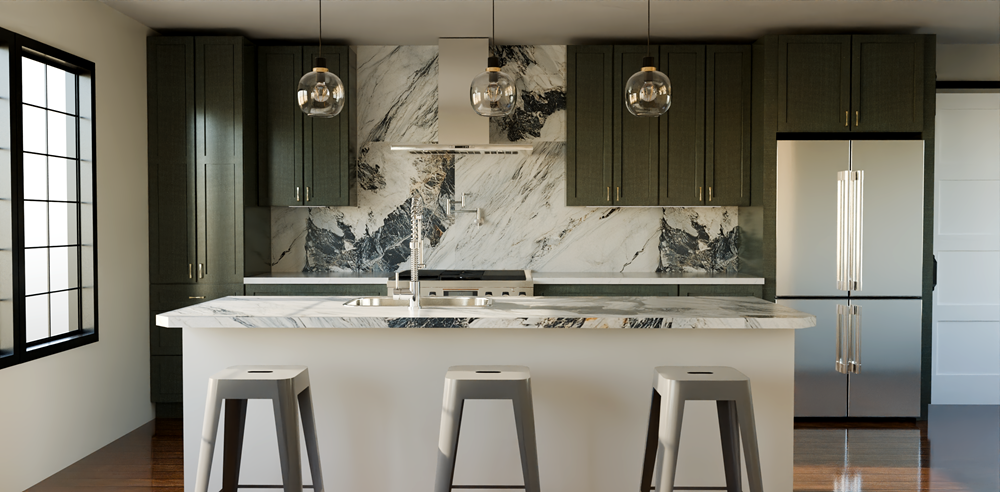Kitchen layout ideas: The ultimate guide for design professionals
Kitchen Bathroom

Cheryl Hay, CKBD

A well-designed kitchen layout isn't just about making things look good – it's about making everything work together. For certified kitchen and bath designers, layout is the foundation of every project, influencing how clients move through the space, how meals are prepared, and how storage supports everyday living.
That's why professionals across North America rely on standards set by the National Kitchen & Bath Association (NKBA) – the leading authority in kitchen and bath design. As a long-standing NKBA member, Cyncly aligns with these trusted guidelines to help you ensure every kitchen is as functional as it is beautiful.
This guide presents layout ideas used by professionals throughout North America. Whether you're remodeling or designing from scratch, you'll learn how to plan for performance, flexibility, and longevity – while using best-in-class design solutions like Design Flex to bring those plans to life.
Why kitchen layouts matter in professional design
Every great kitchen starts with layout. It's what determines the flow of cooking, the ease of cleaning, and the vibe of entertaining. Even the most beautiful finishes can't fix a layout that forces users to walk in circles or bend over awkwardly to access key zones.
Certified designers consider a range of factors – traffic flow, sightlines, natural lighting, and ergonomics – long before a cabinet style is ever chosen. That's what separates a stylish kitchen from a professionally functioning one.
Design Flex helps designers visualize layouts in 2D and 3D with real product data, ensuring that every choice – from cabinet width to island placement – is rooted in reality.
Understanding the five foundational layout types
All kitchen layouts fall into one of five primary categories. Mastering these gives you the foundation to design anything from a compact city galley to an expansive open-concept plan.
- L-Shaped: Efficient and often open to adjacent rooms; ideal for corner integration
- U-Shaped: Max storage and counter space for high-function kitchens
- Galley: Linear efficiency; typical in small kitchens and apartments
- Island: Adds workspace and sociability in open layouts
- Peninsula: A substitute for an island when space is tight, offering extra prep and storage
Designers use these shapes as flexible starting points – then adapt based on lifestyle, footprint, and project scope.
Space planning strategies for real-life workflow
Designers don't plan kitchens based on square footage – they plan around how people cook, clean, and move. That's where space planning comes in: it's about designing a kitchen that aligns with real-life behaviors and routines.
Good layout accounts for real habits:
- Is the homeowner left- or right-handed?
- Do they host large gatherings or cook solo?
- Is the fridge opened 50 times a day while the oven gets used once a week?
Key considerations include:
Minimum 42 inches of clearance between counters
According to the National Kitchen & Bath Association (NKBA) Guidelines, the width of a work aisle should be at least 42 inches for a single cook and 48 inches for multiple cooks. These clearances help prevent bottlenecks and allow users to move comfortably, even in busy kitchens with high traffic flow.
Landing zones beside every major appliance
Allocate counter space next to the refrigerator, oven, cooktop, and microwave to support safe and efficient use.
Direct paths between fridge, sink, and cooktop (the work triangle)
Keep the most-used areas easily accessible from one another to reduce back-and-forth and support smooth workflows.
Designers using Design Flex can adjust layouts in real time during client consultations, instantly testing different movement paths or cabinet configurations.
Design zones and the modern kitchen triangle
The classic “work triangle” – connecting the sink, cooktop, and refrigerator – remains a foundational principle in kitchen layout. It helps minimize unnecessary movement and supports efficient meal prep.
According to the National Kitchen & Bath Association (NKBA) Guidelines, in kitchens with three work centers, the sum of the triangle's three sides should not exceed 26 feet. No single leg should be less than 4 feet or more than 9 feet. These measurements help maintain a comfortable workflow that minimizes unnecessary steps without crowding the space.
But in modern spaces, the kitchen triangle rule alone is too simplistic. Today's households often have multiple cooks, more appliances, and higher expectations for how the space supports everyday life. That's why designers now think in zones – functional areas built around real tasks:
- Prep zone: Ample counter space near the sink with quick access to knives, cutting boards, and prep tools
- Cooking zone: Cooktop or oven with nearby landing space and storage for pots, pans, and utensils
- Cleanup zone: Sink, dishwasher, and trash/recycling access grouped for post-meal efficiency
- Landing zone: Designated space to set down groceries, serving platters, or hot dishes from the oven
Zoning helps reduce friction between tasks and supports multiple users working in the kitchen at the same time. It's especially effective in multigenerational households, open floorplans, or any kitchen that sees a lot of traffic throughout the day.
Integrating appliances, storage, and surfaces
Great layout isn't just about shape – it's about integration. A thoughtful design blends appliances, cabinetry, and worktops into a cohesive system.
- Use panel-ready appliances to maintain a streamlined look
- Add storage towers or appliance garages to reduce counter clutter
- Include pull-outs, toe-kick drawers, and blind-corner organizers to reclaim lost space
Design Flex allows you to visualize these integrations with product-specific dimensions, helping clients understand how everything fits – before anything is installed.
When to break the rules for style or space
Design is part logic, part artistry. There are times when bending layout rules leads to a better solution.
Examples include:
- Floating an island asymmetrically to support visual interest
- Putting the sink in the island to face family or guests
- Eliminating upper cabinets for more openness and natural light
The key is to know why you’re breaking the rule – and to test the impact before committing. Digital planning software like Design Flex makes it easy to simulate and evaluate non-traditional layouts with clients in real time.
Common pitfalls and how to fix them
|
Pitfall |
Solution |
|
Traffic jams near the fridge |
Plan for appliance clearances and traffic flow from the start to minimize revisions. |
|
Insufficient landing space |
Add required landing areas immediately after placing appliances. (15–18 inches minimum) |
|
Cabinet doors clashing or overlapping |
Use 3D planning tools and Design Flex item attributes to check clearance and adjust hardware |
|
Poor lighting in key areas |
Add layered lighting to illuminate all zones effectively. |
Planning solves most problems before they happen. That's why layout should always be step one.
Next-level enhancements with digital visualization
Design Flex enables designers to go beyond layout theory. You can:
- Easily display cabinet layout changes and finish options.
- Instantly switch between saved rendering views to show multiple perspectives of completed designs.
- Show clients real-time renderings of their kitchen in progress as you revise and redesign
This gives certified professionals a huge advantage – especially during early consultations, where decisions about space and flow can lock in client confidence and reduce costly revisions later on.
Design Flex is also integrated into many academic design programs across North America, helping students learn space planning best practices alongside real-world visualization tools.
A successful kitchen starts with the right layout. Whether you're a professional designer or a homeowner working with one, understanding the logic behind kitchen layouts, work triangles and traffic flows, is essential to delivering lasting performance and style.
At the core of all great layouts is the ability to think through real-world movement, make informed decisions about space, and bring ideas to life with the right tools.
With Design Flex and a solid foundation in professional design principles, you'll be well positioned to create kitchens that look stunning and function flawlessly. Professional results start here. Get started with Design Flex.
Related blogs

How brand inconsistency threatens kitchen/bath retail expansion
8/31/2025
A fragmented experience across locations can erode customer trust. Here’s how to preserve your brand while scaling your kitchen and bath business.

Kitchen interior design tips for modern homes: What works and why?
8/13/2025
Explore advanced interior design strategies for kitchens that elevate both function and aesthetics.

3D Kitchen Planner: Full guide to get started
8/8/2025
Discover how a 3D kitchen planner can transform your design process, boost client engagement, and accelerate sales with realistic visualizations and smart automation.